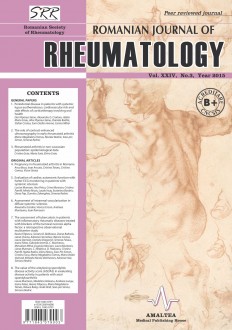SELECT ISSUE

Indexed

| |

|
|
|
| |
|
|
|

|
|
|
|
|
|
| |
|
|
HIGHLIGHTS
National Awards “Science and Research”
NEW! RJR has announced the annually National Award for "Science and Research" for the best scientific articles published throughout the year in the official journal.
Read the Recommendations for the Conduct, Reporting, Editing, and Publication of Scholarly work in Medical Journals.
The published medical research literature is a global public good. Medical journal editors have a social responsibility to promote global health by publishing, whenever possible, research that furthers health worldwide.
EVALUATION OF CARDIAC AUTONOMIC FUNCTION WITH HOLTER ECG MONITORING IN PATIENTS WITH SYSTEMIC SCLEROSIS
Lucian Muresan, Ana Petcu, Crina Muresan, Cristina Pamfil, Mirela Rinzis, Laszlo Irsay, Ecaterina Bordnic, Dana Pop, Dumitru Zdrenghea and Simona Rednic
ABSTRACT
Purpose. Cardiac autonomic dysfunction is frequently encountered among patients with systemic sclerosis. Its presence correlates with potentially fatal ventricular arrhythmias, having a good positive predictive value for mortality. The aim of this paper was to identify cardiac autonomic dysfunction in patients with systemic sclerosis using Holter ECG monitoring and to assess the possible correlations between its presence and other disease characteristics.
Material and methods. Forty nine patients with diffuse cutaneous and limited cutaneous scleroderma, diagnosed according to the American College of Rheumatology/EULAR 2013 criteria underwent ECG, transthoracic echocardiography, blood sample testing, chest X-ray and spirometry. Subsequently, all patients and a control group of 49 healthy subjects underwent Holter ECG monitoring with time and frequency domain heart rate variability (HRV) analysis.
Results. Scleroderma patients had significantly lower HRV values compared to controls: SDNN (123 ± 39.4 vs. 143.2 ± 32, p =0.001), SDANN (137.2 ± 34.9 vs. 127.9 ± 25.7, p=0.001), TI (-) (30.6 ± 9.6 vs. 38.1 ± 8.9, p=0.01) and TINN (758.8 ± 208 vs. 815.1 ± 138, p=0.04). The LF/HF ratio was significantly higher among patients with diffuse scleroderma (1.18 ± 0.34 vs. 1.08 ± 0.43, p= 0.005). There was a positive correlation between the TI values, SDANN and the duration from the onset of Raynaud’s phenomenon (r=0.399, p=0.016) (r=0.419, p=0.011), between the SDANN values and systolic pulmonary arterial pressure (sPAP) values (0.032, p=0.034) and a negative correlation between the LF/HF values and the patients’ age (r=-0.442, p=0.001), the duration from the onset of non-Raynaud’s phenomenon (r=-0.395, p=0.034), echocardiographic value of sPAP(r=-0.330, p=0.035) and the total number of premature ventricular contractions (r=-0.0459, p=0.001).
Conclusion. Patients with systemic sclerosis often have cardiac autonomic dysfunction, which can be diagnosed with Holter ECG monitoring.
Keywords: systemic sclerosis, heart rate variability, Holter ECG
